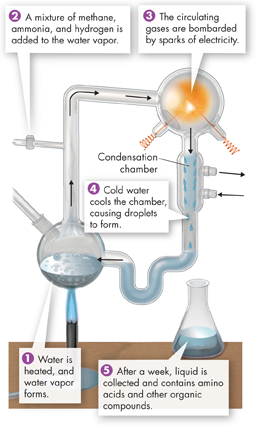The First Organic Molecules Could organic molecules assemble under conditions on early Earth? In 1953, chemists Stanley Miller and Harold Urey tried to answer that question. They filled a sterile flask with water, to simulate the oceans, and boiled it. To the water vapor, they added methane, ammonia, and hydrogen, to simulate what they thought had been the composition of Earth's early atmosphere. Then, as shown in Figure 19–15, they passed the gases through electrodes, to simulate lightning. Next, they passed the gases through a condensation chamber, where cold water cooled them, causing drops to form. The liquid circulated through the experimental apparatus for a week. The results were spectacular: They produced 21 amino acids—building blocks of proteins.  Miller and Urey's experiment suggested how mixtures of the organic compounds necessary for life could have arisen from simpler compounds on a primitive Earth.
Miller and Urey's experiment suggested how mixtures of the organic compounds necessary for life could have arisen from simpler compounds on a primitive Earth.
We now know that Miller and Urey's ideas on the composition of the early atmosphere were incorrect. But new experiments based on current ideas of the early atmosphere have also produced organic compounds. In fact, in 1995, one of Miller's more accurate mixtures produced cytosine and uracil, two bases found in RNA.

FIGURE 19–15 Miller-Urey Experiment Miller and Urey produced amino acids, which are needed to make proteins, by passing sparks through a mixture of hydrogen, methane, ammonia, and water vapor. Evidence now suggests that the composition of Earth's early atmosphere was different from their 1953 experiment. However, more recent experiments with different mixtures of gases have produced similar results.
dFormation of Microspheres A stew of organic molecules is a long way from a living cell, and the leap from nonlife to life is the greatest gap in scientific hypotheses of life's early history. Geological evidence suggests that during the Archean Eon, 200 to 300 million years after Earth cooled enough to carry liquid water, cells similar to bacteria were common. How might these cells have originated?
Large organic molecules form tiny bubbles called proteinoid microspheres under certain conditions. Microspheres are not cells, but they have some characteristics of living systems. Like cells, they have selectively permeable membranes through which water molecules can pass. Microspheres also have a simple means of storing and releasing energy. Several hypotheses suggest that structures similar to proteinoid microspheres acquired the characteristics of living cells as early as 3.8 billion years ago.
Evolution of RNA and DNA Another unanswered question is the origin of RNA and DNA. Remember that cells are controlled by information stored in DNA, which is transcribed into RNA and then translated into proteins. How could this complex biochemical machinery have evolved?
Table of Contents
- Formulas and Equations
- Applying Formulas and Equations
- Mean, Median, and Mode
- Estimation
- Using Measurements in Calculations
- Effects of Measurement Errors
- Accuracy
- Precision
- Comparing Accuracy and Precision
- Significant Figures
- Calculating With Significant Figures
- Scientific Notation
- Calculating With Scientific Notation
- Dimensional Analysis
- Applying Dimensional Analysis




